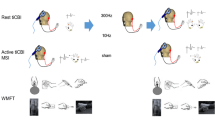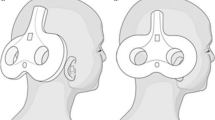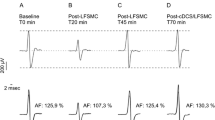Abstract
The cerebellum regulates execution of skilled movements through neural connections with the primary motor cortex. A main projection from the cerebellum to the primary motor cortex is a disynaptic excitatory pathway relayed at the ventral thalamus. This dentatothalamocortical pathway receives inhibitory inputs from Purkinje cells of the cerebellar cortex. These pathways (cerebellothalamocortical pathways) have been characterized extensively using cellular approaches in animals. Advances in non-invasive transcranial activation of neural structures using electrical and magnetic stimulation have allowed us to investigate these neural connections in humans. This review summarizes various studies of the cerebellothalamo-cortical pathway in humans using current transcranial electrical and magnetic stimulation techniques. We studied effects on motor cortical excitability elicited by electrical or magnetic stimulation over the cerebellum by recording surface electromyographic (EMG) responses from the first dorsal interosseous (FDI) muscle. Magnetic stimuli were given with a round or figure eight coil (test stimulation) for primary motor cortical activation. For cerebellar stimulation, we gave high-voltage electrical stimuli or magnetic stimuli through a cone-shaped coil ipsilateral to the surface EMG recording (conditioning stimulation). We examined effects of interstimulus intervals (ISIs) with randomized condition-test paradigm, using a test stimulus given preceded by a conditioning stimulus by ISIs of several milliseconds. We demonstrated significant gain of EMG responses at an ISI of 3 ms (facilitatory effect) and reduced responses starting at 5 ms, which lasted 3–7 ms (inhibitory effect). We applied this method to patients with ataxia and showed that the inhibitory effect was only absent in patients with a lesion at cerebellar efferent pathways or dentatothalamocortical pathway. These results imply that this method activates the unilateral cerebellar structures. We confirmed facilitatory and inhibitory natures of cerebellothala-mocortical pathways in humans. We can differentiate ataxia attributable to somewhere in the cerebello-thalamo-cortical pathways from that caused by other pathways.
Similar content being viewed by others
References
Allen GI, Tsukahara N. Cerebrocerebellar communication systems. Physiol Rev. 1974;54:957–1006.
Hoover JE, Strick PL. The organization of cerebellar and basal ganglia outputs to primary motor cortex as revealed by retrograde transneuronal transport of herpes simplex virus type 1. JNeurosci. 1999;19:1446–63.
Holdefer RN, Miller LE, Chen LL, Houk JC. Functional connectivity between cerebellum and primary motor cortex in the awake monkey. J Neurophysiol. 2000;84:585–90.
Jörntell H, Ekerot C, Garwicz M, Luo XL. Functional organization of climbing fibre projection to the cerebellar anterior lobe of the rat. J Physiol. 2000;522(Pt 2):297–309.
Na J, Kakei S, Shinoda Y. Cerebellar input to corticothalamic neurons in layers V and VI in the motor cortex. Neurosci Res. 1997;28:77–91.
Sasaki K, Kawaguchi S, Oka H, Sakai M, Mizuno N. Electrophysiological studies on the cerebellocerebral projections in monkeys. Exp Brain Res. 1976;24:495–507.
Shinoda Y, Kakei S, Futami T, Wannier T. Thalamocortical organization in the cerebello-thalamo-cortical system. Cereb Cortex. 1993;3:421–9.
Steriade M. Two channels in the cerebellothalamocortical system. J Comp Neurol. 1995;354:57–70.
Barker AT, Freeston IL, Jabinous R, Jarratt JA. Clinical evaluation of conduction time measurements in central motor pathways using magnetic stimulation of human brain. Lancet. 1986;1(8493):1325–6.
Ugawa Y, Uesaka Y, Terao Y, Hanajima R, Kanazawa I. Magnetic stimulation of corticospinal pathways at the foramen magnum level in humans. Ann Neurol. 1994;36:618–24.
George MS, Wassermann EM, Post RM. Transcranial magnetic stimulation: A neuropsychiatric tool for the 21st century. J Neuropsychiatry Clin Neurosci. 1996;8:373–82.
Ugawa Y, Day BL, Rothwell JC, Thompson PD, Merton PA, Marsden CD. Modulation of motor cortical excitability by electrical stimulation over the cerebellum in man. J Physiol. 1991;441:57–72.
Ugawa Y, Rothwell JC, Day BL, Thompson PD, Marsden CD. Percutaneous electrical stimulation of corticospinal pathways at the level of the pyramidal decussation in humans. Ann Neurol. 1991;29:418–27.
Day BL, Dressler D, Maertens de Noordhout A, et al. Electric and magnetic stimulation of human motor cortex: surface EMG and single motor unit responses. J Physiol. 1989;412:449–73.
Day BL, Thompson PD, Dick JP, Nakashima K, Marsden CD. Different sites of action of electrical and magnetic stimulation of the human brain. Neurosci Lett. 1987;75:101–6.
Amassian VE, Stewart M, Quirk GJ, Rosenthal JL. Physiological basis of motor effects of a transient stimulus to cerebral cortex. Neurosurgery. 1987;20:74–93.
Sakai K, Ugawa Y, Terao Y, Hanajima R, Furubayashi T, Kanazawa I. Preferential activation of different I waves by transcranial magnetic stimulation with a figure-eight-shaped coil. Exp Brain Res. 1997;113:24–32.
Ugawa Y, Iwata NK. Cerebellar stimulation in normal subjects and ataxic patients. In: Hallett M, Chokroverty S, editors. Magnetic stimulation in clinical neurophysiology, 2nd edn. Amsterdam: Elsevier BV; 2005. pp 197–210.
Amassian VE, Stewart M. Motor cortical and other cortical interneuronal networks that generate very high frequency waves. Suppl Clin Neurophysiol. 2003;56:119–42.
Hanajima R, Ugawa Y, Terao Y, et al. Paired-pulse magnetic stimulation of the motor cortex: Difference among I waves. J Physiol. 1998;509:607–18.
Ugawa Y, Uesaka Y, Terao Y, Hanajima R, Kanazawa I. Magnetic stimulation over the cerebellum in humans. Ann Neurol. 1995;37:703–13.
Iwata NK, Hanajima R, Furubayashi T, et al. Facilitatory effect on the motor cortex by electrical stimulation over the cerebellum in humans. Exp Brain Res. 2004;159:418–24.
Ugawa Y, Hanajima R, Kanazawa I. Interhemispheric facilitation of the hand area of the human motor cortex. Neurosci Lett. 1993;160:153–5.
Hanajima R, Ugawa Y, Machii K, et al. Interhemispheric facilitation of the hand motor area in humans. J Physiol. 2001;531(Pt 3):849–59.
Ugawa Y, Genba-Shimizu K, Rothwell JC, Iwata M, Kanazawa I. Suppression of motor cortical excitability by electrical stimulation over the cerebellum in ataxia. Ann Neurol. 1994;36:90–6.
Ugawa Y, Terao Y, Hanajima R, et al. Magnetic stimulation over the cerebellum in patients with ataxia. Electroencephalogr Clin Neurophysiol. 1997;104:453–8.
Sakai K, Kojima E, Suzuki M, et al. Primary motor cortex isolation: Complete paralysis with preserved primary motor cortex. J Neurol Sci. 1998;155:115–9.
Ugawa Y, Terao Y, Nagai C, Nakamura K, Kanazawa I. Electrical stimulation of the cerebellum normally suppresses motor cortical excitability in a patient with ataxia due to a lesion of the middle cerebellar peduncle. Eur Neurol. 1995;35:243–4.
Di Lazzaro V, Molinari M, Restuccia D, et al. Cerebrocerebellar interactions in man: neurophysiological studies in patients with focal cerebellar lesions. Electroencephalogr Clin Neurophysiol. 1994;93:27–34.
Matsunaga K, Uozumi T, Hashimoto T, Tsuji S. Cerebellar stimulation in acute cerebellar ataxia. Clin Neurophysiol. 2001;112:619–22.
Ugawa Y, Genba-Shimizu K, Kanazawa I. Suppression of motor cortical excitability by electrical stimulation over the cerebellum in Fisher’s syndrome. J Neurol Neurosurg Psychiatry. 1994;57:1275–6.
Author information
Authors and Affiliations
Corresponding author
Rights and permissions
About this article
Cite this article
Iwata, N.K., Ugawa, Y. The effects of cerebellar stimulation on the motor cortical excitability in neurological disorders: A review. Cerebellum 4, 218–223 (2005). https://doi.org/10.1080/14734220500277007
Received:
Accepted:
Issue Date:
DOI: https://doi.org/10.1080/14734220500277007




